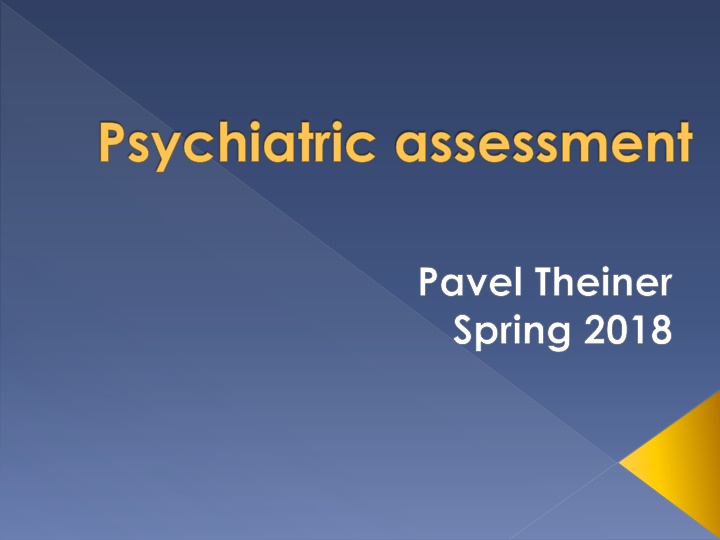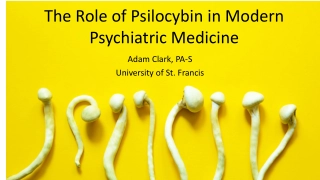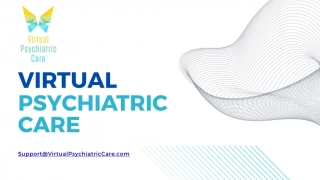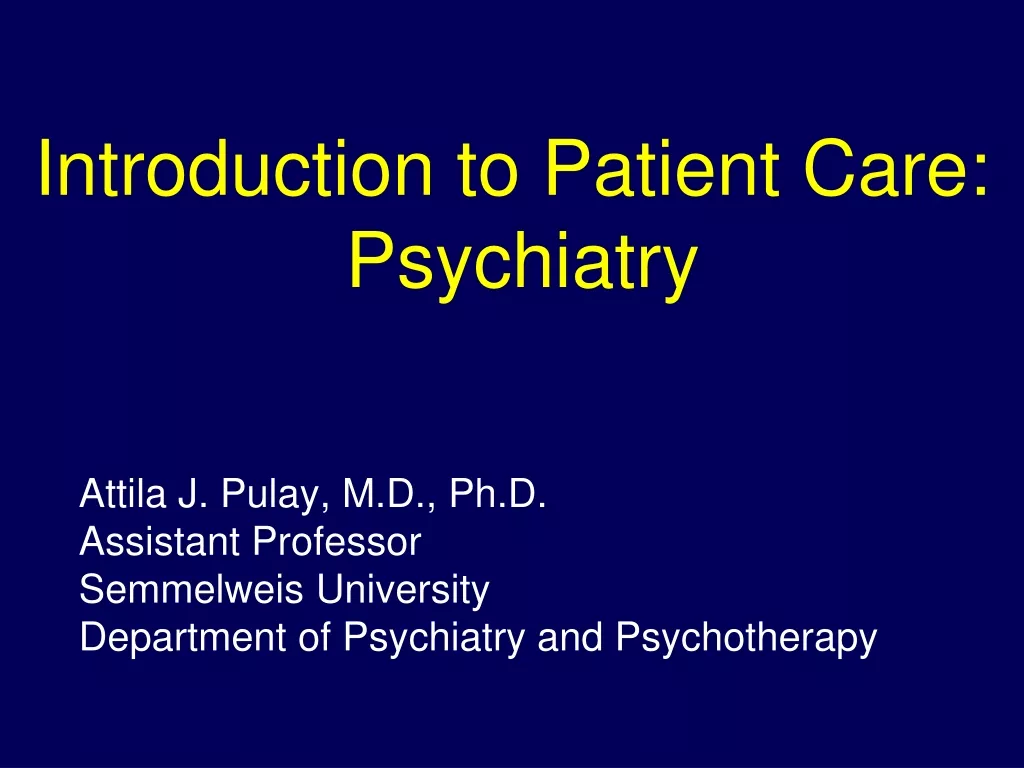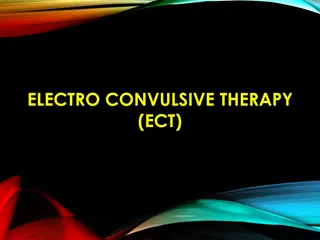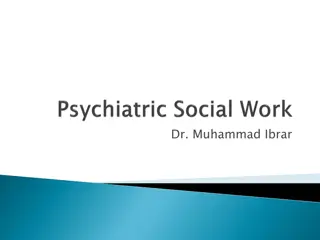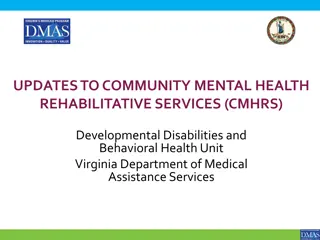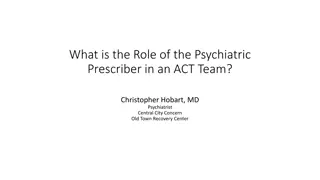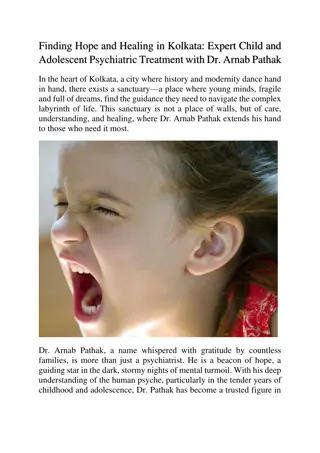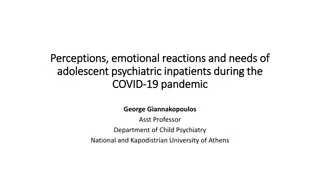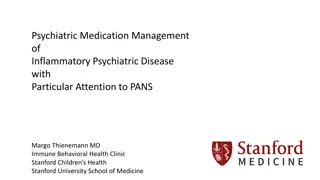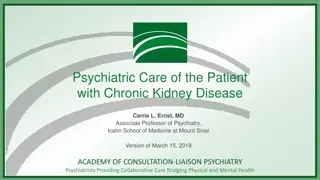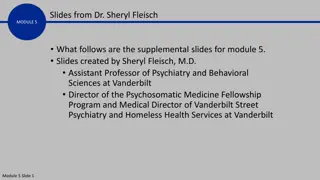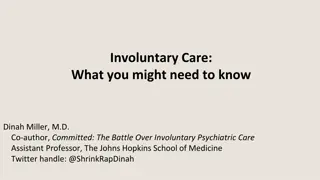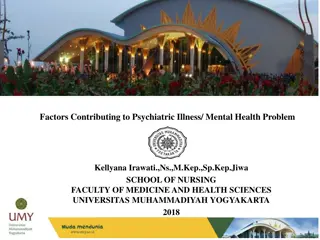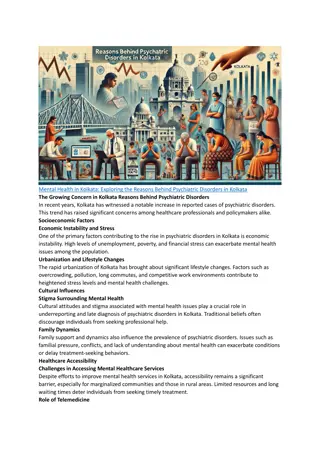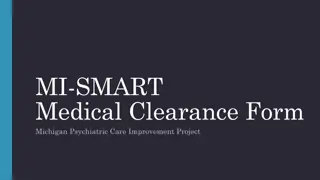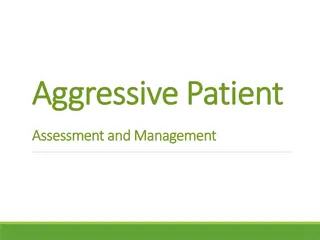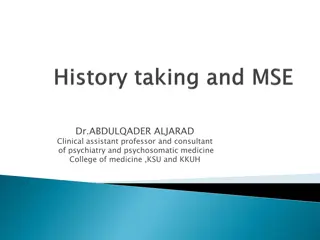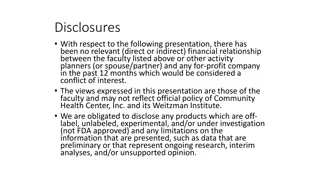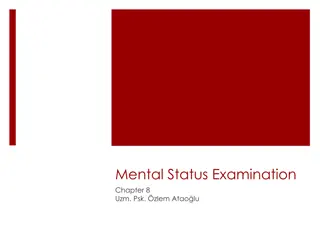Comprehensive Guide to Psychiatric Assessment Techniques
This detailed resource covers various aspects of psychiatric assessment including general overview, clinical interview techniques, patient meeting strategies, applying interviewing techniques, reflecting patient feelings, and summarizing patient thoughts. The content emphasizes the importance of a diagnostic interview in guiding treatment and outlines best practices for conducting thorough psychiatric evaluations.
Download Presentation

Please find below an Image/Link to download the presentation.
The content on the website is provided AS IS for your information and personal use only. It may not be sold, licensed, or shared on other websites without obtaining consent from the author.If you encounter any issues during the download, it is possible that the publisher has removed the file from their server.
You are allowed to download the files provided on this website for personal or commercial use, subject to the condition that they are used lawfully. All files are the property of their respective owners.
The content on the website is provided AS IS for your information and personal use only. It may not be sold, licensed, or shared on other websites without obtaining consent from the author.
E N D
Presentation Transcript
Psychiatric assessment Pavel Theiner Spring 2018
General overview https://www.youtube.com/watch?v=7a c2IND4Yls
Clinical interview: Psychiatric history and mental status general introduction choosing a place and meeting the patient applying interviewing techniques taking a psychiatric history mental status examination
General introduction the purpose of a diagnostic interview is to gather information that will help the examiner make a diagnosis - the diagnosis guides treatment psychiatric diagnoses are based on descriptive phenomenology: signs, symptoms, and clinical course the psychiatric examination consists of the two arts: a psychiatric history, and mental status examination
Choosing a place and meeting the patient choose a quiet place new patients will almost certainly be anxious (being worried by their symptoms and about what the assessment will be like) shake hand and introduce yourself, use formal address (i.e. Mr., Ms.), invite patient to sit down be sure your patient understands the reason for your meeting (e.g. to evaluate the problems) your interviewing style: helping your patient tell you what is wrong!
Applying interviewing techniques allow the interview to flow freely, let patient describe the events of his/her live in any order he/she chooses, encourage him/her to elaborate on thoughts and feelings provide structure for pts. who have trouble ordering their thoughts -specific questions phrase your question to invite the patient to talk (open vs. closed questions) avoid (mis)leading questions help patient to elaborate ( Tell me more about it, please go on )
Applying interviewing techniques reflect your patient s feeling back to him (correctly verbalise patient s feelings) paraphrase the patient s thought ( You mean, you did not feel better? ) summarise what the patient has said additional tips : avoid jargon, use the patient s words, avoid asking why, identify thoughts versus feelings, avoid premature reassurance
Taking a psychiatric history Identifying data: (name, age, ethnic, sex, occupation, number o children, place of residence) Referral source Chief complaint ( What brings you to see me? ) History of the present problem: onset of problem duration and course psychiatric symptoms severity of problem possible precipitants
Taking a psychiatric history Past psychiatric history: all previous episodes and symptoms prior treatments and response, hospitalisations The best predictor of future treatment response is past treatment response !
Taking a psychiatric history Personal history: Infancy: birth history, developmental milestones Childhood: pre-school years, school, academic performance Adolescence: onset of puberty, early sexual experience, peer relationships Adulthood education, military experiences, employment social life, sexual history, marriage, children
Taking a psychiatric history Family history of mental illness Medical history: current medical condition and treatment major past illnesses and treatments medical hospitalisations surgical history Drug and alcohol history
Mental status examination 1. Appearance and behaviour (dress, facial expression, eye contact, motor activity) 2. Speech (rate, clarity) 3. Emotions (affect) 1. subjective - patient s description 2. objective -emotion communicated through facial expression, body posture and vocal tone Mood - a sustained emotion, Affect - the way the patient shows feelings - variability, intensity, liability, appropriateness)
Mental status examination 4. Thought a. thought speed b. thought form: the way ideas are linked (logical, goal-directed, loose associations) c. thought content: delusions (false beliefs) thought insertion, thought withdrawal depersonalisation and derealisation preoccupations, obsessions - unwanted idea that cannot be eliminated by reasoning phobia- obsessive, unrealistic fear
Thought Examples of questions (concerning thought disorder): Do you think anyone wants to hurt you? Do you feel that others can hear your thoughts or read your mind? Additional tips: When something does not appear to make sense, always ask for clarification!!
Mental status examination 5. Perception: misinterpreting sensory input - illusion perceiving sensory input in the absence of any actual external stimulus - hallucination ( Do you ever hear voices or see things other people do not hear or see? ) Determine to what extent the patient is driven to actions based on a hallucination !
Mental status examination 6. Sensorial and intellectual functions: alertness (degree of wakefulness) orientation to person, place, time and situation concentration (to focus and a sustain attention) memory recent and remote, immediate recall (repeat 5 number forwards and backwards) calculation (simple arithmetic) fund of knowledge abstraction (proverbs, similarities) judgement and insight
Diagnostic systems in psychiatry 2 diagnostic systems: American (American Psychiatric Association, APA) DSM 5 European and international (WHO) ICD-10
Basic Terms in Psychiatry Psychiatry studies the causes of mental disorders, gives their description, predicts their future course and outcome, looks for prevention of their appearance and presents the best ways of their treatment Psychopathology describes symptoms of mental disorders Special psychiatry is devoted to individual mental diseases General psychiatry studies psychopathological phenomena, symptoms of abnormal states of mind: consciousness perception thinking mood (emotions) memory intelligence motor personality
Disorders of Consciousness Consciousness is awareness of the self and the environment Disorders of consciousness: qualitative quantitative short-term long-term
Disorders of Consciousness Quantitative changes of consciousness mean reduced vigility (alertness): somnolence sopor coma
Disorders of Consciousness Qualitative changes of consciousness mean disturbed perception, thinking, affectivity, memory and consequent motor disorders: delirium (confusional state) characterized by disorientation, distorted perception, enhanced suggestibility, misinterpretations and mood disorders obnubilation (twilight state) starts and ends abruptly, amnesia is complete; the patient is disordered, his acting is aimless, sometimes aggressive, hard to understood
Disorders of Orientation Orientation by oneself (autopsychic) Knows his/her name, address, date of birth Orientation by circumstances (allopsychic) Time Place Situation
Disorders of Mood (Emotions) Normal affect brief and strong emotional response Normal mood subjective and for a longer time lastingdisposition to appear affects adequate to a surrounding situation and matters discussed
Disorders of Mood (Emotions) Pathological affect very strong, abrupt affect with a short change of consciousness on its peak Pathological mood two poles: manic depressive Phobia persistent irrational fear and wish to avoid a specific situation, object, activity
Disorders of Mood (Emotions) Pathological mood: origin based on pathological grounds, usually no psychological cause duration unusually long-lasting intensity unusually strong, large changes in intensity impossibility to be changed by psychological or voluntary means Pathological moods: euphoria expansive exaltation explosive maniac (hypomaniac) depressive anxious apathy (anhedonia) blunted, flattened affect emotional lability helpless https://www.coursera.org /learn/international- psychiatry/lecture/X6IZW/ the-affect-in-the-mental- state-examination
Disturbances of Perception Perception is a process of becoming aware of what is presented through the sense organs Imagery means an experience within the mind, usually without the sense of reality that is normal Pseudoillusions distorted perception of objects which may occur when the general level of sensory stimulation is reduced Illusions are psychopathological phenomena; they appear mainly in conditions of qualitative disturbances of consciousness (missing insight) Hallucinations are percepts without any obvious stimulus to the sense organs; the patient is unable to distinguish it from reality
Disturbances of Perception Hallucinations: auditory (acousma) visual olfactory gustatory tactile (or deep somatic) extracampine, inadequate intrapsychic (belong rather to disturbances of thinking) hypnagogic and hypnopompic Pseudohallucinations - patient can distinguish them from reality
Disorders of Thinking Thinking: Goal-directed flow of ideas and associations initiated by a problem and leading toward a reality-oriented conclusion. Thinking is a very complex and complicated mental function The evaluation of thoughts is based on what the patient says (via speech)
Disorders of Thinking Disorders of thinking: Thought process (formal disorders) Speed Structure Thought content
Disorders of Thinking Quantitative (formal) disorders of thinking: poverty of thought thought blocking flight of ideas perseveration loosening of associations word salad - incoherent thinking neologisms verbigeration https://www.coursera.org/learn/international- psychiatry/lecture/BzKL8/the-thought-process-in-the-mental- state-examination
Disorders of Thinking Qualitative disorders of thought (content thought disorders): Delusions: belief of (usually) bizzare content formed by logical thinking process but based on a pathological assumption or imput not corrected by rational arguments not a conventional belief (not shared) influence the behaviour
Disorders of Thinking Qualitative disorders of thought (content thought disorders): Obsessions (obsessive thought) are recurrent persistent thoughts, impulses or images entering the mind despite the person's effort to exclude them. Obsessive phenomena in acting (usual as senseless rituals cleaning, counting, dressing) are called compulsions. https://www.coursera.org/learn/internation al-psychiatry/lecture/klFvK/thought- content-and-the-delusion
Delusions - division according to onset a) primary (delusional mood, perception) b) secondary (systematized) c) shared (folie deux) according to the topic a) paranoid (persecutory) - d. of reference, d. of jealousy, d. of control, d. concerning possession of thought b) megalomanic (grandiose, expansive) d. of power, worth, noble origin, supernatural skills and strength, amorous d. c) depressive (micromanic, melancholic) d. of guilt and worthlessness, nihilistic d., hypochondriacal d. d) concerning the possession of thoughts thought insertion thought withdrawal thought broadcasting
Melancholic delusions delusion of self accusation (false interpretation of real past event resulting in feeling of guilt) hypochondriac delusion (false belief of having a fatal physical illness or bizarre somatic sondition) nihilistic delusions (false feeling that self, others or the world is non-existent or ending) delusions of failure (false belief that one is unable to do anything useful) delusion of poverty (false belief that one lost all property)
Delusions of grandeur delusion of importance (exaggerated conception of one s importance) delusion of power, extrapotence (exaggerated conception of one s abilities/possibilities) delusion of identity/origin (false belief of being the offspring of member of an important family) Messiah delusion
Paranoid delusions delusion of persecution (false belief that one is being persecuted) delusion of infidelity (false belief that one s partner is unfaithful) erotomanic delusion (false belief, that someone is deeply in love with them)
Delusion of control false feeling that one s will, thought, movements or feelings are being controlled by someone else May include: Thought withdrawal Thought insertion Thought broadcasting Thought control
Disorders of Memory Sensory stores - retains sensory information for 0.5 sec. Short - term memory (working memory) - for verbal and visual information, retained for 15-20 sec., low capacity Long-term memory wide capacity and more permanent storage declarative (explicit) memory episodic (for events) semantic (for language and knowledge) procedural memory for motor patterns
Disorders of Memory Quantitative: Hypermnesia Hypomnesia Amnesia anterograde retrograde Usually with amnestic desorientation and confabulations
Disorders of Memory Qualitative (paramnesia) Distorted memory tracks
Disorders of Attention Concentration Capacity Tenacity Irritability Vigility Hypoprosexia (global, selective) Hyperprosexia Paraprosexia
Disorders of Volition hypobulia abulia hyperbulia
Presentations Psychosis: https://www.youtube.com/watch?v=ZB28gf Smz1Y&t=35s Depression: https://www.youtube.com/watch?v=4Yhp WZCdiZc Mania: https://www.youtube.com/watch?v=zA- fqvC02oM&list=PLFZTljPAn- Kx257X3b9ET8qZfVOcC8V5o&index=7&t=0s
